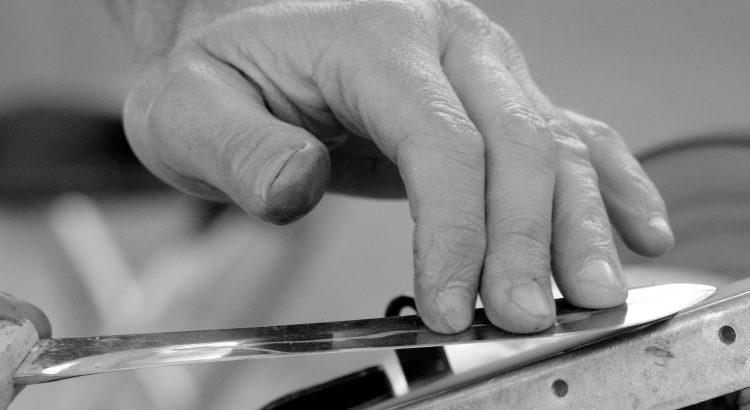While sharpening a knife may seem like a simple task, the reality is that’s it’s not so simple. Sharpening a knife properly is an art that requires lots of practice and experience, and without it, your results may be mediocre at best. In some cases, incorrectly sharpening a knife may lead to irreparable damage.
In today’s article, we’re going to learn that sharpening a knife is an extremely precise process that leaves little room for improvisation. Below are some tips to help you sharpen your knife the correct way.
Why do we sharpen knives?
You can think of a knife as a type of micro-saw. The reason for a blade’s sharpness is because its thin edge has numerous serrations at a microscopic level. With every use, these serrations are smoothed until they completely disappear, leaving the blade ‘flat’ and then the knife is no longer able to cut into the material. At this point, you must sharpen your knife.
Sharpened knife
The word sharpening means restoring the thin serration of the blade as much as possible. Sharpening is not a simple task because the microscopic serrations are difficult for the naked eye to see, which makes it hard to see how much a blade is sharpened. Due to this reason, there are processes put into place in order to guarantee proper sharpening.
There are two types of sharpening: maintenance and grinding. Maintenance sharpening can be done with another knife or sharpener, whereas grinding, also known as true sharpening, is necessary when the knife performs and cut blade. When grinding, a whetstone or sharpener is used.
A whetstone is a tool which sharpens a blade by means of rubbing and are usually made of ceramic. You may have seen sharpening wheels before, which can be categorized as whetstones with the difference being that it must be lubricated with water or oil as opposed to manual whetstones. With manual whetstones, it’s good practice to lubricate with a little bit of sharpening oil for maximum performance. When you’re ready to sharpen, the blade should be slid on the whetstone in the opposite directions of its cutting edge. The sharpening work begins on the coarser side, which is used for grinding, and the finer side is used for sharpening.
A matter of angle
When sharpening knives, the consistency of your movement and above all, the angle at which you sharpen your knife is the most important aspect. The smaller the sharpening angle between the blade and whetstone, the sharper the blade becomes. With this in mind, does it mean it’s necessary to always sharpen at a small angle? The answer is no, because the more a blade is sharpened, the more fragile it becomes, and the more often it has to be sharpened. This is where experience comes into play, as it’s important to find an angle that
Speed is not as important as the consistency of movement, and, above all, the angle. Thousands of pages of physics books discuss the matter, and legends were born. We try to simplify our life: the smaller the sharpening angle between the whetstone and the blade, the sharper the blade becomes. So is it necessary to sharpen at a very small angle? No, because sharpening also corresponds with greater fragility. As such, the sharper the blade is, the more often it has to be sharpened. This is why, with experience, it is necessary to find an angle that offers just the right amount of compromise. In most cases, the perfect sharpening angle is 20°.
The sharpener
Sharpeners are another tool which is generally used for maintenance sharpens. They offer lighter action when compared to whetstones. The function is sharpeners is to put the microscopic serrations of the blade back in line after they’ve been bent in different directions after usage.
Using a sharpening is easy. Simply hold it firmly and slide it along the length of the blade with a linear and continuous movement. The angle of the blade with respect to the sharpened should be approximately 20°. Maintenance sharpening can be performed as soon as you start to feel your knife is losing its cutting performance. When the sharpened is no longer enough to restore your knife’s original cutting ability, it’s time to move to the whetstone.
If you’re in an emergency situation where you don’t have access to sharpening tools, there is one little trick you can perform. Simply take a ceramic coffee cup, turn it upside down, and pass the blade on the edge of the bottom of the cup approximately a dozen times at a 20° angle.
